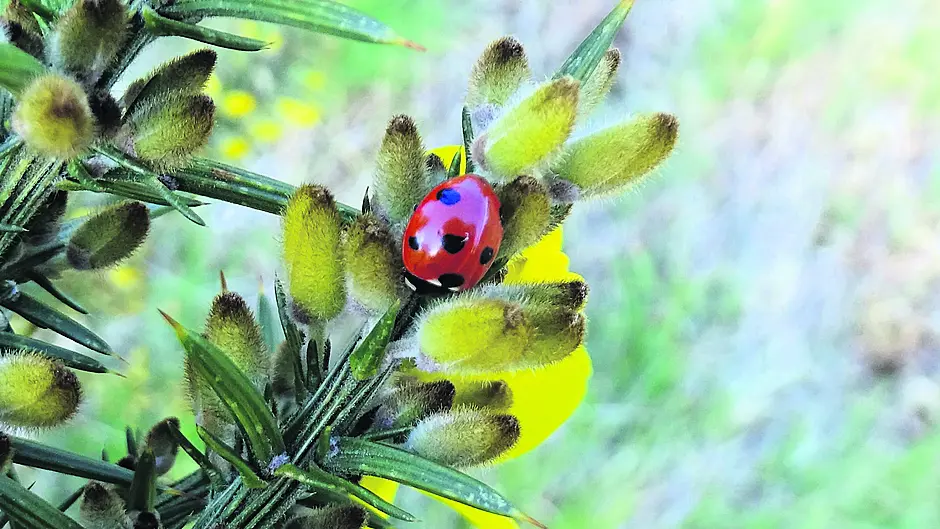By Ann Haigh
AS I walked down our local boreen recently with my son, we admired the fabulous yellow blossom that is starting to show on the gorse bushes. The saying goes ‘When gorse is out of blossom, kissing’s out of fashion,’ which is lucky for us as gorse can bloom year-round. In spring the gorse flowers are certainly at their most dramatic and in a few weeks’ time the roadsides will be further emblazoned with yellow.
Peering into the gorse, my son and I spotted ladybird after ladybird inside many of the bushes as we progressed along our walk
The ladybirds we spotted were 7-spot ladybirds, one of Ireland’s most common species. Ladybirds overwinter in their adult form and seek sheltered sites to snuggle down in for the period between October and February. Refuge from the elements may be sought in a variety of locations, such as under tree bark, amongst leaf litter or even sometimes within our homes and sheds. Gorse is a particularly popular choice for several species. They usually emerge from March onwards and begin to feed. Most ladybirds, both the adults and the larvae, eat small insects and aphids, including green fly, which make them much-loved by gardeners. After regaining some strength and energy after their winter slumber, and as the weather continues to get warmer, they will then start to mate.
Life-cycle
Most mating takes place in late April and early May. After mating, females lay eggs on the underside of vegetation. In the insect world, the official term for “hatching” is “eclosing” and the ladybird eggs eclose relatively quickly with tiny larvae emerging after about 7 days. These larvae feed, grow and develop over a period of 3 to 4 weeks before pupating. Ladybirds emerge from pupae after about one to two weeks. The ladybird life-cycle is an example of metamorphosis and the sequence goes from egg to larva to pupa to adult.
Depending on the species, ladybirds may produce one or two generations per year. When winter once again approaches the new adults seek out sites to overwinter and on goes the cycle of life.
Ladybird wee
Last year my son claimed that a ladybird ‘did a wee’ on his hand and indeed the ladybird had left a miniscule puddle of yellow behind. Interestingly, this was not urine but a clever defence mechanism whereby ‘reflex blood’ is secreted from their leg joints when they feel threatened. This fluid is repellent and full of alkaloids which are, at best, horrible tasting and, at worst, toxic for many predators. Luckily the ‘wee’ is harmless for humans, albeit a little pungent.
Zombie ladybirds
Since ladybirds have such clever defence strategies, that does beg the question, what successful predators do ladybirds have?
Some birds will manage to feed on them, but the most fascinating predators ladybirds have are actually wasps.
Several parasitic wasp species can prey on ladybirds, with Dinocampus coccinellae being one of the main ones. A tiny female wasp will lay an egg into the underside of a ladybird via a long needle-like ovipositor. When the egg hatches, the larva feeds on the insides of the ladybird, often keeping the ladybird alive for extended periods and turning them into ‘zombie bodyguards.’
Ladybird species
Over the years it has been hard to say exactly how many species of ladybird there are in Ireland. This is because some species were only spotted here once or twice so it has been hard to know if they are resident.
Recently it has been accepted that there are 19 species of ladybird in the Republic of Ireland.
The orange ladybird is one of my favourites. It is unusual because unlike most ladybird species that favour aphids for dinner, both adults and larvae of this species like to munch on the powdery mildew that grows on the underside of leaves. Adults are quite tiny, only measuring approximately 5 mm in length, and are orange with 14 to 16 creamy white spots.
Invasive harlequins
A threat to our native ladybirds is a non-native species called the harlequin ladybird. It is thought this species first arrived in County Cork in 2010 and has since become resident. While generally larger than our native species, they can be tricky to identify as they are quite variable in appearance. Close examination is required to distinguish them from some of our native species. Harlequins not only compete for food, but they also prey on the larvae of our native ladybirds, putting them in danger.
Ladybird Atlas 2025
To better understand the status, threats and distribution of our Irish ladybirds the National Biodiversity Data Centre (NBDC) is renewing efforts this year to collect data to inform a Ladybird Atlas by 2025. Over the next two years, they are requesting the help of the public to report their ladybird sightings to them at www.biodiversityireland.ie/surveys/ladybird-atlas-2025/.
How to help ladybirds
To have a wildlife friendly garden it is best to avoid the use of chemicals. As winter approaches, ladybirds need dry and sheltered places to hide away in and piles of logs or leaves in your garden are ideal for this.
Ladybirds are a group that really benefit from insect hotels.
Maybe you already have one, but if you don’t you can easily make one yourself by following some simple online instructions, or perhaps buy one from a garden center.
In the meantime, we are going to make the most of the spring and summer by heading out to look for ladybirds to report to the Ladybird Atlas 2025.
• Ann Haigh MVB MSc MRCVS is a Skibbereen resident, a mum-of-two and a veterinarian with a masters in wildlife health and conservation and she is passionate about biodiversity and nature.








